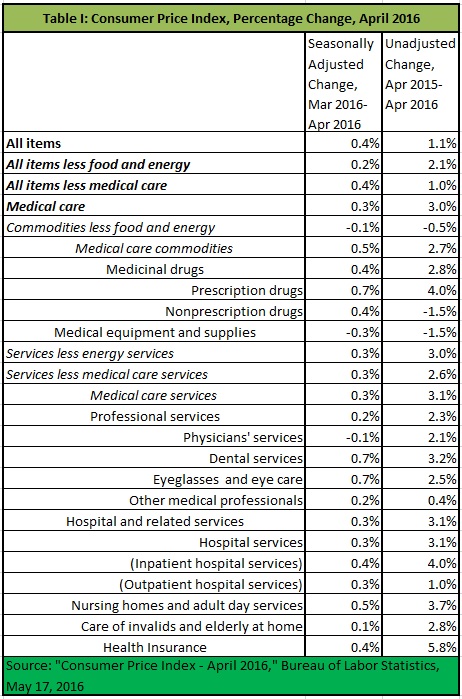CPI: Medical Inflation Finally Under Control
 The Consumer Price Index (CPI) for April confirmed medical inflation is matching the broad measure of price changes. For the second month, price changes for medical care (0.3 percent) were in line with all-items (0.4 percent). Although, it looks like a jump in energy prices drove the CPI up. If energy price increases moderate, we can expect prices for medical care to increase faster than CPI.
The Consumer Price Index (CPI) for April confirmed medical inflation is matching the broad measure of price changes. For the second month, price changes for medical care (0.3 percent) were in line with all-items (0.4 percent). Although, it looks like a jump in energy prices drove the CPI up. If energy price increases moderate, we can expect prices for medical care to increase faster than CPI.
With respect to medical commodities, it prices of prescription drugs continued to increase faster than other medical commodities or commodities over all. Although, pharmaceutical price hikes in the CPI are not as big as in the Producer Price Index. Prices for many health goods and services actually dropped.
However, over the last twelve months, medical prices faced by consumers have grown much faster than non-health prices: 3.0 percent versus 1. percent. Prescription prices increased 4.0 percent, as did prices for inpatient hospital services. Health insurance increased 5.8 percent.
(See Table I below the fold.)



Based on the research provided in this article, I wanted to introduce myself and share some information on a new healthcare system that I am involved in.
As mentioned in the article above, the consumer price for insurance has recently skyrocketed. Because of this, my team and I have created a solution that removes insurance companies completely. Our solution is Kumba Health.
Here’s how we think about Kumba Health. For those with high deductible insurance plans, healthcare doesn’t work like it used to. 100M Americans with high deductible insurance will go out of pocket more than $420B this year (staggering, right?). Making this more interesting is the fact that the millennials (a bigger cohort than the boomers) are entering the healthcare market for the first time (meaning getting off their parents’ policies) and tend to use the internet for everything, plus the growth of the so called 1099 economy. And remember, there are still millions of Americans without insurance, despite the ACA.
Consumers now need a better way to “shop” for their healthcare, now that they are the ones increasingly footing the bill. We created Kumba Health as an online marketplace of direct pay providers for exactly this reason. And what makes it work so well, is that providers covet this very patient (almost universally, doctors want to reallocate their patient portfolio away from insurance plans towards direct pay).
Kumba currently consists of a variety of providers, including physicians, imaging centers, and labs around the Los Angeles area, and is quickly expanding throughout California (and then the country!). For a low monthly membership fee, providers can introduce their practice to the exact customer they most want – direct pay. What they do with all their spare time (due to not having to deal with insurance) is up to them.
Here are some quick links on Kumba if you are interested in learning more.
• From the consumer’s perspective: vimeo/143095250
• From the provider’s perspective: vimeo/133493268
Best,
Dana
Kumba Health